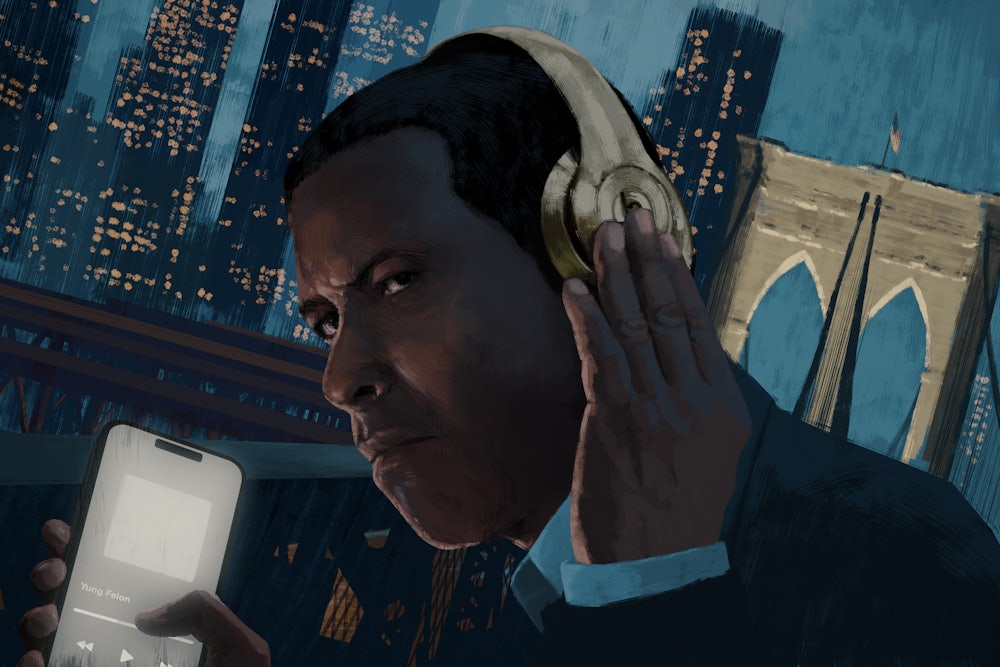In the opening credits of Spike Lee’s Highest 2 Lowest, the camera glides over the East River, admiring an Elysian New York City skyline against a peachy sunrise. Skyscrapers parade like diamond obelisks across the screen, while the booming baritone of Gordon MacRae, singing “Oh, What a Beautiful Mornin’” from Rodgers and Hammerstein’s Oklahoma!, augments this dreamy decadence: Everything’s going my way. Indeed. At the very top of the tallest building in the neighborhood, the camera settles on David King (Denzel Washington), a powerful music executive taking a business call on his penthouse’s balcony. He’s a tower among towers, quite literally, his reflection on his dwelling’s glazed exterior cast against Manhattan’s silhouette. This rapturous introduction swiftly establishes a kind of epic context—a grand city, a great man, played by one of the movie world’s most virtuosic stars—and we haven’t even stepped inside yet.
Once we do, we find David’s two-story loft, filled with Basquiats and Kehinde Wileys; artistic renderings of Toni Morrison and Frederick Douglass; framed portraits of David on the covers of Rolling Stone and Time. There are his adoring queen, Pam (Ilfenesh Hadera), and teenage heir, Trey (Aubrey Joseph), who aspires to carry on his pop’s legacy. David is the founder of Stackin’ Hits Records, an eminent music label that has signed over 50 Grammy-winning artists; call him the Quincy Jones of the new millennium.
Signifiers of Black excellence aren’t unusual in Lee’s films—think of the archival montage of Black leaders like Muhammad Ali, Malcolm X, and Tommie Smith that kicks off Da 5 Bloods (2020). But for a writer-director who has always anchored his stories of Black lives to the broader arc of Black American history, Highest 2 Lowest’s glossy demonstration of prestige and success feels unique. We’re no longer in the sweaty, working-class Brooklyn of Do the Right Thing (1989), Crooklyn (1994), and He Got Game (1998), but in present-day Dumbo—one of the borough’s most affluent neighborhoods, a tech company hub and commercial district that embodies the lifeless upscale aesthetics of gentrification. David and Pam are like Beyoncé and Jay-Z, Barack and Michelle—Black icons, yes, but also unapologetic capitalists; money, of course, being the most efficient means of achieving the American dream.
The same day that David is set to buy out one of Stackin’ Hits’ board members, allowing him to regain control of the company, he receives an anonymous call informing him that Trey is being held for ransom. The demand? $17.5 million in Swiss francs, around the sum David needs to execute his business plan. The Kings prepare to hand over the cash, but when it turns out that Trey is safe, and Kyle (Elijah Wright)—Trey’s best friend and the son of Paul (Jeffrey Wright), David’s driver and confidant—is the one in danger, David slackens.
Highest 2 Lowest is an adaptation of Akira Kurosawa’s 1963 film, High and Low (which is itself based on Ed McBain’s 1959 detective novel King’s Ransom), and it mirrors the moral conflict, class divisions, and anxieties about mechanization and modern technology in the Kurosawa. David balks at a potentially lucrative deal with an AI company because good music needs “heart” and “soul,” while the kidnapping, and his initial refusal to pay Kyle’s ransom, lay bare his own callous individualism. A devastated Trey, swarmed by online haters decrying his family’s inaction, accuses his father of having the “coldest heart.”
Though Kurosawa’s classic features the great Toshiro Mifune in the equivalent of Washington’s role, it doesn’t rely on its lead actor’s stardom to build out its ideas about the economic stratification of postwar Japan. Casting Washington as David, however, and featuring him alongside the unofficial Black hall of fame on the penthouse’s walls, call attention to the actor’s celebrity and decades-spanning career. And to those of Lee, who rose to prominence on a similar timeline to Washington’s, and whose work in the 1990s, in particular, was defined by their partnership. In this sense, Highest 2 Lowest, Lee and Washington’s fifth collaboration, is a quintessential “late” film, entwining the source narrative’s social issues with a meta-reckoning on inheritance and memory, especially as it relates to high-profile Black artists charged with representational responsibility. David is caught between doing the right thing and revamping his career, which brings to mind the ultimatums faced by popular artists in profit-oriented creative industries: speak out on a politically divisive issue, for instance, and risk slashing your fan base and hemorrhaging sales. An expressly political filmmaker who has also been called a “corporate populist,” and who embraces commercial genres and lucrative product placements (the Nike swag is ubiquitous), Lee is certainly attuned to the difficulties of honoring one’s principles while maintaining the hustle.
Unfortunately, this first hour of domestic drama and soul-searching is also tonally bewildering. Its overt symbolism (David’s Mount Olympus is Dumbo’s Olympia Building); broad, theatrical performance styles; and hyper-expressive score by Howard Drossin betray a camaraderie with the conventions of the classic melodrama. Yet the script’s blunt sincerity, coupled with the eerie artificiality of the Kings’ hyper-curated abode, make its big emotions feel stale and/or unintentionally kitschy. In other words, it sort of feels like a Lifetime movie—more soap opera than psychodrama. The leonine Washington, at the very least, is infinitely watchable; his cocky swagger and sharp shifts to dagger-eyed intensity lend these conversational scenes a certain grit and sense of humor. There’s a moment when, racked by indecision and pacing around his home office, David cries out and invokes his forebears: What would you do, James [Brown]? What would you do, Stevie [Wonder]? Jimi [Hendrix]? Aretha [Franklin]? It’s rather silly, but I can’t deny that Washington delights.
When David finally agrees to pay Kyle’s ransom, his decision is fueled by both moral and practical considerations: The boy is an unofficial member of the family, sure, but failure to act also means backlash that could jeopardize Stackin’ Hits already plummeting rep. Aided by a team of cops (LaChanze plays a brainy sleuth; Dean Winters, the meatheaded muscle), David descends from his perch to carry out the ransom exchange, and the change of scenery—from glossy high-rise to street-level scramble—is demarcated by a switch to a moody, grainier format. Here, Lee’s signatures pop out: An ethereal double-dolly shot captures Detective Bridges (John Douglas Thompson) in close-up as he explains the plan to seize the kidnappers. Drossin’s score turns jazzy and percussive as David and two of the detectives take the 4 subway line up through Manhattan and into the Bronx, where the kidnapper and his lackeys await the drop-off. As demonstrated with his previous Washington collab, the bank-heist thriller Inside Man (2006), Lee has a gift for harmonizing the thrills of multilocation set pieces. With Highest 2 Lowest, he puts his New Yorker and avid sports-fan credentials to work, introducing the city’s communal rhythms and public gatherings as unforeseen hurdles. The Puerto Rican Day Parade is in full swing, clogging the streets around which the drop-off is meant to take place; the Yankees are playing a home game, and rabid Boston-hating fans are packed into the 4 train. The kidnapper, a paragon of street smarts, plays these factors to his advantage, securing the money bag with a few decoys and motorbikers that breeze through the crowds. Brooklynite though David may be, his potty-mouthed rival proves he’s flown too high and forgotten how to fight on land.
But if David has lost touch with the New York of his youth—the same New York that a much younger Washington inhabited in his early films with Lee, like Mo’ Better Blues (1990) and He Got Game—he’s still got his talent. As Pam sagely points out, however, corporate interests threaten to distract him from what really matters: the music. Dubbed the “best ears in the business,” a line so frequently repeated in the film it becomes something of a joke, David licks the wounds left by his hefty financial loss by reconnecting with his past. As in the old days, he walks the length of the Brooklyn Bridge while listening to new music. A trap single by the conspicuously named “Yung Felon” grabs his attention; the rapper’s voice resembles that of the kidnapper’s crude pronouncements, and Kyle, now safe in the hospital, confirms it’s the same song that had been playing on loop throughout his confinement. Naturally, the cops refuse to prioritize David’s lead, claiming they’ll verify the connection, if there is one, by running the song and the kidnapper’s call recordings through AI technology. Police incompetence, ever the motivation for vigilante justice, is joined by gratuitous automation—a poor substitute for human expertise.
Lee’s films tend to work through themes dialectically. See the pair of quotes by Martin Luther King Jr. and Malcolm X that appear at the end of Do the Right Thing, which serve to muddle the arguments for and against their conflicting philosophies on violence. Highest 2 Lowest, too, stakes out sundry dichotomies to create ambiguities, ultimately pitting David against the rough-edged yet unexpectedly charismatic Yung Felon (A$AP Rocky) in a Stygian showdown. Paul, a reformed criminal, hits up the amorphous network referred to simply as “the streets” to locate Yung Felon’s whereabouts, kicking off the film’s loosest and most pleasurable section. David and Paul behave like chums gearing up for one last rumble, and a weirdly charming encounter with Yung Felon’s clueless baby momma (Princess Nokia) reveals that Mr. Felon is but a disgruntled fan of David’s desperate to grab his attention; a passionate yet largely invisible musician whose tracks are buried in music streamers’ algorithms. A mesmerizing face-off (and partial rap battle) between David and Yung Felon in the younger man’s underground recording studio plays out like an intergenerational powwow between Black artists—Black men with competing ideas about everything, including women, power, and what makes a sick beat.
Lee’s own convictions take center stage in David’s final stand. Once arrested, Yung Felon goes viral, his notoriety bringing him the attention—and record deal offers—he’d always dreamed of. But even now, he wants David’s validation, and in a split screen confrontation in the prison visiting room, he offers himself to Stackin’ Hits Records—a proposition he’s sure will rake in the dough. In films like Bamboozled (2000), about a modern-day minstrel show, Lee calls out the exploitation of Black identities by media narratives, underscoring a career-long fixation with the reclamation of Black representation. By this logic, Yung Felon’s trendy, social media–bolstered fame, premised on stereotypes of Black criminality, is destined to fade. Meanwhile, David, in the film’s concluding scene, leaves Stackin’ Hits behind to start a new family-owned business: steer clear of stupid spectacle, stick to your roots, and follow your gut. I can’t say that Highest 2 Lowest stands among Lee’s greatest hits, but it certainly preserves the idiosyncrasies that distinguish his filmmaking, proving at the very least that Spike continues to abide by his own rules—and that’s something to be celebrated.




